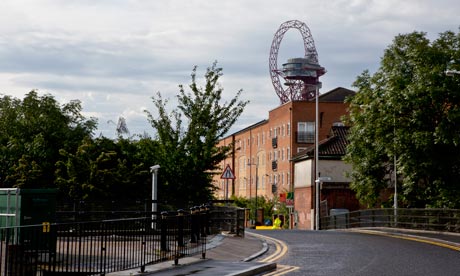(Português) Since 2009, planning deals in the Olympic area in east London have shown little commitment to regeneration and local needs.

As London prepares to host the Olympic and Paralympic Games, the government has once again announced new plans to boost infrastructure spending to kickstart our sluggish economy. The whole London 2012 project is based on the logic that major investment will accelerate regeneration in east London. But as the starting pistol is fired, research shows the event will not meet the promises made by successive governments since 2005.
When London won the Olympic bid, the vision of an inclusive regeneration project was underpinned by a commitment to creating mixed communities and reducing social deprivation. It was anticipated that the housing legacy, in particular, would help deliver these goals and extend beyond the parameters of the park.
In 2005, researchers at the London East Research Institute began monitoring planning agreements on housing schemes of 50 or more units along Stratford high street. The high street serves as a good case study because of its close proximity to the Olympic Park and provides clear evidence of accelerated regeneration: 2,321 properties have been developed since 2000 and a further 753 are planned. We explored the planning gain agreements on all schemes with signed section 106 (S106) agreements.
Planning gain based on S106 agreements is significant; they are the mechanism for capturing value and more generally mitigating the impact on local communities. Our research study set out to explore the extent to which accelerated regeneration has occurred and the benefits that have been derived from this for local communities. We focused on two dimensions — contributions to affordable housing and financial contributions intended to mitigate the impact of developments.
The agreements were analysed across three periods: the years immediately prior to London winning the bid (2000-2005); the early pre-event phase, marked by substantial planning gain activity and significant numbers of affordable housing units being developed; and finally the period since 2009 – in which there has been minimal commitment to achieving wider benefits for local communities.
Between 2000 and 2005, three schemes were developed (including 484 units) reflecting a growing interest in this area due to planned developments such as Stratford City and Eurostar.
Planning gain requirements were less about maximising developmentand more about ensuring development took place. Nevertheless, these schemes included 21% affordable housing and the majority of this wasshared ownership (75%).
Newham was keen to rebalance the housing tenure in Stratford, which at this time was dominated by housing for social rent. Between 2005 and 2008, development increased at a rapid pace. The Olympics provided confidence in the area and seven schemes came to fruition, leading to the construction of 1,902 new properties (38% affordable, with a 48:52 split between intermediate housing and social rented housing).
However, since 2009 there has been a dramatic departure from previous commitments to mixed communities and on-site affordable housing. Three schemes have been approved with signed S106 agreements. These agreements do not include any on-site affordable housing for social rent and just 7.5% on-site shared ownership. On two schemes contributions are made to off-site affordable housing (16%) and on the third scheme affordable housing is subject to profitability. Moreover, financial contributions to offset the impact of developments have fallen substantially and are now way below the actual cost to local authorities when new housing is built.
There are three main explanations for this. The first is that cuts to government grant funding make it more difficult to fund affordable housing; secondly, planning frameworks have been relaxed with scope for manoeuvre over specific levels of affordable housing provided; and thirdly, development agencies are keen to encourage activity – and from their perspective more private housing may be preferable to no housing development.
Land comes at a premium in London and most new affordable housing is likely to be developed in east London as there are more vacant sites available. However, every site or scheme that includes very low or no on-site affordable housing for rent exacerbates the housing crisis for families on low incomes. These developments will shape subsequent activity on surrounding sites and indicates that poor families will eventually be pushed out of this area.
This was reflected in the outline planning application for Ikea’s mixed use development to the south of Stratford High Street. The scheme is significant as it includes 1,192 properties and covers a large area of land. The rapidly decreasing requirements for affordable housing are once again evident here. The scheme proposes 10% on-site affordable housing with a 50:50 split between affordable rent and intermediate housing, with a commitment to increase this to 15% if market conditions prevail.
I would suggest that it is just as important to explore housing change on the borders of the Olympic Park to understand housing legacy as it is to focus exclusively on the Park. Policy makers are hoping that there will be a convergence in living standards with residents in the east and west of London. The danger is that this will be achieved by simply changing the population mix rather than transforming the lives of existing east London communities.
Dr Penny Bernstock is a field leader at the University of East London. Professor Gavin Poynter is chair of the London East Research Institute
This content is brought to you by Guardian Professional. Join thehousing network for more comment, analysis and best practice
Source: The Guardian

Leave a Reply